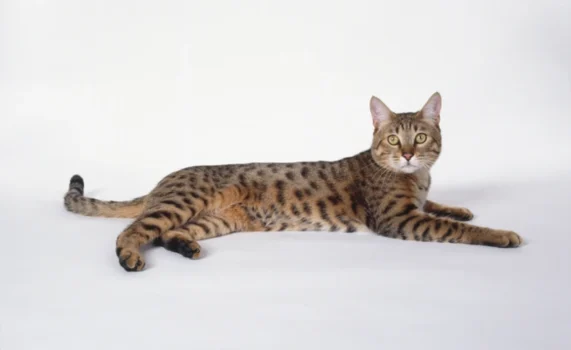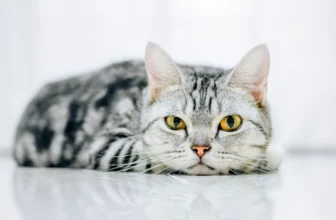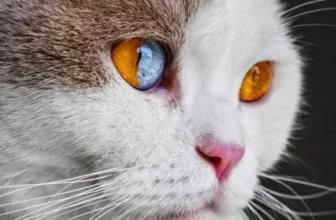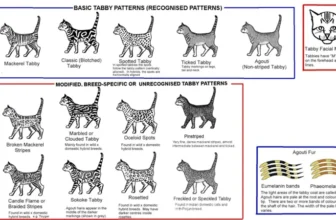As feline enthusiasts, we all know that cats come in all shapes, sizes, and colors. One of the most striking features on a cat is their eyes. The California Spangled cat breed is known for their unique and captivating eye coloration. But as with any genetic trait, there is a lot of complexity behind the scenes. That’s why we’re diving into the genetics of eye color in California Spangled cats. In this article, we’ll explore the basics of eye color genetics, the role of melanin in eye color, breeding impact, and the latest research on California Spangled eye color. So, sit tight and prepare to be amazed by the fascinating world of feline genetics.
What are California Spangled Cats?
California Spangled Cats are a breed that was developed in the 1980s by a group of cat breeders in California. This breed was specifically bred to resemble wild cats like the leopard and ocelot, but with a domesticated temperament. As the name implies, the breed originated in California, but it quickly gained popularity worldwide because of its unique appearance and playful personality.
One of the most striking features of California Spangled Cats is their eye color. This breed is known for having a variety of eye colors, from blue to green to gold to even heterochromatic eyes. The color of their eyes is influenced by genetics, as well as external factors like age and care.
While California Spangled Cats are similar in appearance to wild cats, they are actually well-suited for living in a domestic environment. These cats are known for being active, playful, and affectionate with their owners. They have a reputation for being intelligent and easy to train, making them great pets for families with children or other pets.
California Spangled Cats are a unique and interesting breed that is worth learning about. Whether you are interested in their eye color genetics or simply want to learn more about their playful personalities, there is always more to discover about these fascinating felines.
Why Study Eye Color Genetics in Cats?
Understanding eye color genetics in cats, particularly in California spangled cats, is important for several reasons. First, it helps breeders produce cats with desirable eye colors, which can affect the marketability of the cats. Secondly, it can help veterinarians identify potential health issues related to eye color. For example, some eye colors are linked to a higher risk of certain diseases. Thirdly, research on eye color genetics in cats can also contribute to a broader understanding of genetics and inheritance patterns in animals and humans.
California spangled cats are known for their striking eye colors, which can range from blue to gold to green. Some individuals can even have heterochromatic eyes, meaning each eye is a different color. Understanding the genetics behind these unique eye colors can provide insights into the evolution and development of California spangled cats. Additionally, being aware of the various eye colors and their potential implications can help owners provide proper eye care for their beloved felines.
In the following sections of this article, we will delve deeper into the genetics of eye color in California spangled cats and explore the impact of breeding and other factors on eye color. We will also discuss current research and what scientists are learning about eye color in these fascinating felines.
If you are interested in learning more about specific features of California spangled cat eyes, such as the role of age on eye color or beauty of amber eyes, be sure to check out our articles on aging, amber eyes, and heterochromatic eyes.
Goals of this Article
The main goal of this article is to provide detailed information about the genetics of eye color in California Spangled Cats. This will include a discussion about the various types of eye pigments and how they are controlled by genes, as well as an explanation of Mendelian inheritance patterns. Additionally, this article will outline the role of melanin in eye color and how breeding can impact the expression of certain traits.
One of the primary purposes of this article is to shed light on the importance of studying eye color genetics in cats, particularly in California Spangled Cats. By understanding the genetic factors that contribute to eye color, cat breeders and enthusiasts can make more informed decisions about breeding practices and can ensure the health and well-being of these unique felines.
This article aims to provide insight into the latest research on California Spangled eye color and how scientists are working to uncover new information about these beautiful cats. Whether you are a cat lover, breeder, or simply interested in genetics, this article will provide a wealth of information about this fascinating topic.
For those who own or are considering owning a California Spangled Cat, understanding the genetics of eye color is critical for proper eye care. From keeping their vision healthy to managing common eye conditions, knowledge of the underlying genetic mechanisms is essential. For more information on caring for California Spangled eyes, check out our guide on California Spangled Eyes Care.
The goal of this article is to provide both a comprehensive and accessible resource for anyone interested in the genetics of eye color in cats, with a special focus on the unique features of California Spangled Cats. Whether you’re a breeder, researcher, or simply a curious cat lover, we hope this article will be informative and insightful. To learn more about specific eye color variations in California Spangled Cats, you can check out our detailed guide on California Spangled Cat Eye Colors.
The Basics of Eye Color Genetics
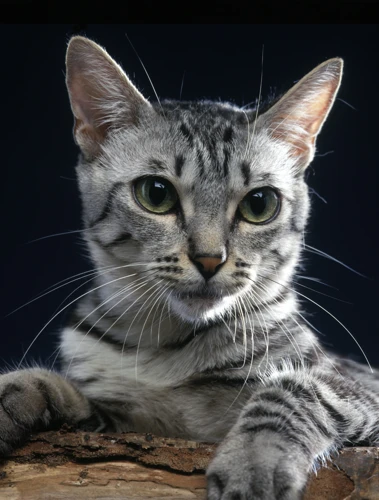
Understanding the basics of eye color genetics is important in understanding the specifics of California Spangled cat eye color genetics. The color of an animal’s eyes is determined by a combination of genes that control the production, transport, and storage of pigments in the iris.
Different Types of Eye Pigments
There are two types of pigments that contribute to eye color: melanin and pheomelanin. Melanin is the most common type of pigment and produces colors ranging from brown to black. Pheomelanin produces colors ranging from yellow to red.
How Genes Control Eye Color
Eye color is a polygenic trait, meaning that it is controlled by multiple genes. The genes responsible for eye color are located on chromosomes and come in pairs, with each parent contributing one gene. The specific combination of genes inherited from each parent determines the offspring’s eye color.
Mendelian Inheritance Patterns
The inheritance of eye color follows Mendelian inheritance patterns. This means that some colors are dominant over others. For example, brown is dominant over blue, so if a cat inherits one brown eye gene and one blue eye gene, its eye color will be brown. However, if a cat inherits two blue eye genes, its eye color will be blue.
Understanding the basics of eye color genetics is important in understanding the specifics of California Spangled cat eye color genetics. Genetics play a significant role in determining the eye color of a California Spangled cat. These cats can have a variety of eye colors such as blue eyes, green eyes and gold eyes. You may know more about eye colors of California Spangled Cats by visiting this link .
Different Types of Eye Pigments
Eye color is a defining feature of cats, and there are a variety of different eye pigment types that can create different colors. The most common pigment is melanin, which is produced by cells called melanocytes. Melanin can range in color from yellow to brown to black, and it affects the overall shade of the eye.
There are two main types of pigment that affect eye color – eumelanin and pheomelanin. Eumelanin is a brownish-black pigment that darkens the eye, while pheomelanin is a yellow to red pigment that lightens the eye. The combination of these pigments is what results in different eye colors, such as blue, green, gold, yellow, orange, and brown.
Blue eyes in cats are the result of low levels of melanin, which allows the blue color of the iris to show through. California Spangled cats, in particular, are known for their striking blue eyes, which can be attributed to the breed’s unique genetic makeup. On the other hand, green and gold eyes are more commonly found in California Spangled cats and are the result of a combination of eumelanin and pheomelanin.
The color of a cat’s eyes is not always determined solely by pigment. For example, the scattering of light can cause some cats’ eyes to appear to change color. Additionally, some cats have a condition called heterochromia, where each eye has a different color due to differing levels of pigment.
Understanding the different types of eye pigments is crucial in studying the genetics behind eye color in California Spangled cats. By analyzing the various pigments present in the iris, researchers can begin to unravel the complex genetic processes that control eye color in felines. To learn more about eye color genetics in California Spangled cats, check out our articles on blue eyes in California Spangled cats and green and gold eyes in California Spangled cats.
How Genes Control Eye Color
Understanding how genes control eye color requires knowledge of basic genetics. Genes are the units of hereditary information that are passed down from parents to offspring. They are made up of DNA, which are long chains of nucleotides that code for specific characteristics. Eye color is determined by more than one gene.
The gene that controls the most variation in eye color is called OCA2. This gene produces a protein that regulates the production of melanin, the pigment that gives color to skin, hair, and eyes. Another important gene involved in eye color is called HERC2. This gene regulates the activity of the OCA2 gene.
The combination of variations in these and other genes determines a person’s eye color. In addition to OCA2 and HERC2, other genes that impact eye color include TYR, SLC24A4, and TYRP1. These genes all work together to regulate the expression of melanin in the iris.
Each gene comes in two versions, or alleles, which can be either dominant or recessive. Dominant alleles are those that are expressed even when only one copy of the allele is present, while recessive alleles are only expressed when two copies of the allele are present. The combination of alleles inherited from both parents will determine a person’s individual eye color.
While many factors can influence the expression of genes that control eye color, including environment and disease, understanding the basic genetics of eye color is crucial in understanding the inheritance patterns observed in California Spangled cats and other species.
Mendelian Inheritance Patterns
When discussing the genetics of eye color, it is important to understand Mendelian inheritance patterns. Gregor Mendel, an Austrian monk and scientist, discovered these patterns in the 1860s. Essentially, Mendelian inheritance patterns describe how genes are passed down from parents to their offspring.
One of the basic principles of Mendelian inheritance is that each offspring inherits one copy of a particular gene from each parent. This means that for most genes, an individual has two copies of the same gene, one from their mother and one from their father.
The specific combination of alleles (different forms of a gene) that an individual inherits will determine their phenotype, or physical trait. Mendelian inheritance also includes the concepts of dominant and recessive traits. A dominant trait will be expressed if an individual has at least one copy of the dominant allele. A recessive trait, on the other hand, is only expressed if an individual has two copies of the recessive allele.
For example, in the case of eye color, brown eyes are dominant and blue eyes are recessive. If an individual inherits a dominant allele for brown eyes and a recessive allele for blue eyes, they will have brown eyes because the dominant trait is expressed. However, if an individual inherits two recessive alleles for blue eyes, they will have blue eyes because the recessive trait is expressed.
Understanding Mendelian inheritance patterns is an essential part of studying the genetics of eye color in California Spangled cats. It allows researchers to predict the likelihood of certain eye colors in offspring based on the eye colors of the parents. This knowledge is especially important for breeders who are trying to selectively breed cats with desirable eye colors, such as golden or green eyes. By applying Mendelian inheritance patterns, breeders can increase the likelihood of producing cats with the eye colors they desire.
The Role of Melanin in Eye Color
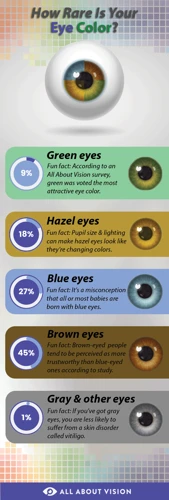
The color of a cat’s eyes, including those of California Spangled cats, is largely influenced by the presence and distribution of melanin. Melanin is a pigment that is responsible for producing colors in the fur, skin, and eyes of cats. It is produced by specialized cells called melanocytes, which are located in the skin and other parts of the body.
How Melanin Affects Eye Color
In the eyes of cats, two types of melanin are produced: eumelanin and pheomelanin. Eumelanin is responsible for producing black and brown eye colors, while pheomelanin produces yellow and orange colors. The amount and distribution of these melanins in the iris determines the final color of the cat’s eyes.
For example, if a cat has a high amount of eumelanin in their iris, their eyes will appear dark brown or black. Conversely, if a cat has a lower amount of eumelanin and a higher amount of pheomelanin, their eyes will appear more amber in color. The presence of both melanins in equal amounts can create green or hazel eyes in cats.
The Genetics of Melanin Production in Cats
The production of melanin in cats is controlled by a number of genes. One of the most important genes involved in determining eye color is the OCA2 gene. This gene encodes for a protein that is involved in the transport of melanin to the iris, where it is deposited and distributed.
Mutations or changes in the OCA2 gene can result in altered melanin production and distribution, which can ultimately lead to changes in eye color. For example, some mutations can cause a reduction in eumelanin production, leading to lighter eye colors. Other mutations can cause an increase in eumelanin production, resulting in darker eye colors.
Other genes involved in melanin production in cats include the TYR and ASIP genes. Mutations in these genes can also impact the production and distribution of melanin, leading to changes in eye color.
The presence and distribution of melanin in the iris plays a significant role in determining the eye color of California Spangled cats and other feline breeds. The genetics of melanin production and distribution are complex and involve multiple genes, making eye color a polygenic trait. Understanding the genetics of eye color in cats can help breeders and researchers better understand the inheritance patterns and potential health implications associated with particular eye colors.
How Melanin Affects Eye Color
Melanin is a crucial pigment responsible for determining eye color in California Spangled Cats. It is produced by melanocytes, a type of cell found in various parts of the body, including the skin, hair, and eyes. The amount and distribution of melanin determine the color of an individual’s eyes.
Two types of melanin: There are two types of melanin that affect eye color: eumelanin and pheomelanin. Eumelanin is responsible for producing brown and black colors, while pheomelanin is responsible for producing red and yellow colors.
The more melanin, the darker the eyes: Individuals with a high concentration of eumelanin will have brown eyes, while those with low concentration of this pigment will have blue or green eyes. Individuals with a higher concentration of pheomelanin will have lighter colored eyes, such as blue, green, or gray.
Influence of genetics: The amount and distribution of melanin in the eyes of California Spangled Cats is largely genetically controlled. This means that the eye color of an individual cat is primarily determined by the genes inherited from its parents. The dominant gene responsible for eye color is the brown or black allele, and the recessive gene is the blue or green allele.
Environmental factors: While genetics plays a significant role in eye color, environmental factors can also influence the activity of genes involved in melanin production. For instance, exposure to UV radiation can stimulate the production of melanin, causing the eyes to darken. On the other hand, certain medications, such as prostaglandins, can decrease the production of melanin, leading to lighter colored eyes.
Melanin is the pigment responsible for determining eye color in California Spangled Cats. The amount and distribution of this pigment is largely genetically controlled, with eumelanin producing dark colors and pheomelanin producing lighter colors. However, environmental factors such as UV exposure can also influence eye color by affecting the activity of melanin-producing genes.
The Genetics of Melanin Production in Cats
The amount of melanin in an animal’s body determines its eye color. Melanin is a pigment molecule that is responsible for brown, black, and gray coloration in cats. It is produced in cells called melanocytes, which are found in the skin, hair, and eyes of mammals. The production of melanin is controlled by a group of genes known as the melanocortin 1 receptor (MC1R) gene, which regulates the activity of melanocytes.
The MC1R gene comes in two different forms, or alleles, in cats. One form is dominant and leads to the production of black pigment, while the other form is recessive and leads to the production of red or orange pigment. When a cat carries two copies of the dominant allele, it will have black eyes. When a cat carries two copies of the recessive allele, it will have blue eyes. The combination of the two alleles creates a range of different eye colors, including green, yellow, and hazel.
Interestingly, the MC1R gene is also responsible for coat color in cats. This means that cats with the same eye color often have similar coat colors. For example, cats with blue eyes tend to have white or gray coats, while cats with green or gold eyes tend to have brown or black coats. However, there are exceptions to this rule, as there are many factors that can influence the expression of genes.
The genetics of melanin production in cats is complex and can be influenced by many different factors. By understanding these factors, researchers may be able to gain insight into the genetics of eye color in California Spangled cats and other breeds.
The Impact of Breeding on Eye Color
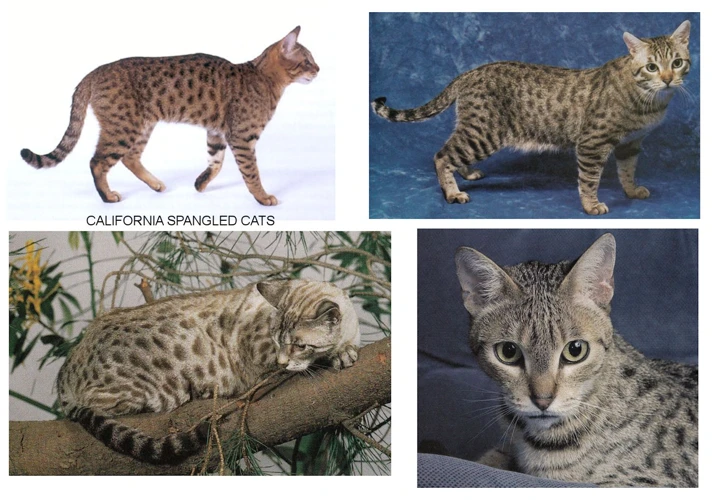
Breeding has a significant impact on the eye color of California spangled cats. It is essential to understand this impact because breeders often aim to produce cats with specific eye colors. However, selective breeding practices can have unintended consequences on the cat’s genetics, health, and eye color.
Breeding for Specific Traits
In California spangled cat breeding, some breeders strive to produce cats with striking eye colors, such as bright blue or bright green. Breeding for specific traits, such as eye color, involves selecting cats with desirable eye colors and breeding them together to produce offspring with the desired trait. However, this practice can lead to unintended consequences.
How Inbreeding Can Affect Eye Color
Inbreeding is another factor that can influence eye color in California spangled cats. Inbreeding involves mating closely related cats to produce offspring with specific characteristics. Unfortunately, this practice increases the likelihood of genetic defects and can result in undesirable eye colors in offspring.
Inbreeding can also cause reduced genetic diversity, making it more challenging for breeders to produce desirable eye colors. In some cases, inbreeding can result in recessive genes becoming more prevalent in the gene pool, leading to unfavorable eye colors.
Inbreeding also increases the risk of health issues in cats. Health issues can manifest as genetic disorders, such as blindness or other eye-related problems. Thus, breeders must be cautious when breeding for specific traits, including eye color, to avoid these unintended outcomes.
Preventing Negative Impacts on Eye Color
To prevent negative impacts on eye color in California spangled cats, breeders should breed for genetic diversity and avoid inbreeding to maintain healthy and desirable traits in offspring. Breeders also need to research their cats’ genetic histories before mating them to avoid breeding cats with genetic disorders that may affect eye color.
Selective breeding practices can impact eye color in California spangled cats. Breeders should strive to maintain healthy genetic diversity in their breeding programs while avoiding inbreeding to ensure desirable eye colors in their cats. It is crucial to consider the long-term health impacts on cats when breeding for specific eye color traits.
Breeding for Specific Traits
Breeding for specific traits is a common practice among cat breeders. This involves selectively breeding cats with desirable characteristics in order to produce offspring with those same attributes. In the case of eye color, breeders may choose to breed cats with particularly bright or unique eye colors in order to pass those traits down to their kittens.
However, it’s important to note that breeding for specific traits can have unintended consequences. While a breeder may be hoping to create cats with stunning blue eyes, there is a chance that this goal could be achieved through inbreeding, which can increase the likelihood of genetic defects and health problems. Similarly, breeding for bright eye color may also inadvertently lead to health issues such as iris coloboma, a condition where the iris is not fully formed.
Responsible cat breeders take care to breed for specific traits in a way that minimizes the risk of genetic problems. They may use a variety of techniques, such as outcrossing (breeding unrelated cats with desirable traits) and genetic testing, to ensure that their breeding program creates healthy, strong kittens with the desired eye color.
It’s worth noting that not all breeders prioritize eye color above all other traits. Many breeders focus on producing cats with strong overall health and temperament, while eye color is just one small piece of the puzzle. However, for those breeders who do prioritize eye color, it’s important to tread carefully and be mindful of the potential risks involved in selectively breeding for specific traits.
How Inbreeding Can Affect Eye Color
Inbreeding refers to the practice of breeding closely related cats, typically from within the same family or line. While inbreeding can lead to an increase in the expression of desired traits, it can also increase the likelihood of genetic disorders and other negative health outcomes, including changes to eye color.
One way inbreeding can affect eye color in cats is through the suppression or loss of genes responsible for producing certain pigments. For example, if two cats with recessive genes for a lack of melanin production are bred together, their offspring may also inherit those genes and have lighter or even completely white eyes. In contrast, if two cats with dominant genes for a certain eye color are bred together, there is a higher likelihood that their offspring will also express that eye color.
Another way inbreeding can impact eye color in cats is through the amplification of pre-existing health conditions. For example, some inherited eye diseases can affect pigmentation and lead to changes in eye color, such as the blue-eyed Siamese cats who may develop progressive retinal atrophy (PRA). When closely related cats are repeatedly bred together, the chances of passing on these issues and affecting eye color increase.
While specific eye colors may be desired by breeders, it is important to consider the potential negative consequences of inbreeding on the overall health of cats. Genetic testing and responsible breeding practices can help to minimize these risks.
Current Research on California Spangled Eye Color
Recent research has revealed fascinating insights into the genetics of eye color in California Spangled Cats. Scientists have discovered that eye color in cats is more complex than previously thought, with different genes contributing to variations in hue, intensity, and pattern. Researchers have found that the expression of eye color genes can be influenced by environmental factors such as nutrition and natural sunlight exposure.
One study conducted at the University of California, Davis, analyzed the genomes of over 200 domestic cats, including several California Spangled Cats, to identify genes associated with eye color. The researchers found that a gene called TYRP1 plays a crucial role in the production of melanin, the pigment that gives color to the iris of the eye. They also found that variations in another gene called OCA2 were strongly linked to variations in eye color across all cat breeds.
Another area of research has focused on the impact of breeding practices on eye color in California Spangled Cats. Some breeders prioritize certain traits, such as blue eyes or unique patterns, leading to the selective breeding that can change the frequency of certain eye color genes in a population. Breeders must be careful, however, as inbreeding can lead to a loss of genetic diversity and a higher likelihood of inheriting detrimental genetic disorders.
Much work still needs to be done to fully understand the complexities of eye color genetics in California Spangled Cats. One promising avenue of research involves examining the regulation of gene expression. Scientists are exploring how factors such as epigenetics, which can influence the level of gene activity, contribute to the expression of eye color genes in cats. This research could lead to new insights into the interaction between genes and the environment, and may eventually pave the way for new approaches to breeding and genetic engineering in cats.
While the genetics of eye color in California Spangled Cats is still a subject of ongoing research, recent studies have revealed a wealth of information about the underlying genetic mechanisms. By studying the interplay between genes and environmental factors, scientists are making exciting progress in unraveling the complexity of eye color genetics.
What Scientists are Learning About Eye Color in California Spangled Cats
Scientists are currently conducting research on the genetics of eye color in California Spangled cats. They are interested in understanding the specific genes responsible for eye color variation in this breed. One area of study is how the melanin production pathway is affected by different genes and how this ultimately results in different variations of eye color.
Additionally, researchers are investigating the role of epigenetics in eye color variation among California Spangled cats. Epigenetic changes can affect gene expression without altering the underlying DNA sequence. This means that the environment during development can influence how genes are expressed and ultimately impact eye color.
One study found that a specific gene, called OCA2, plays a significant role in determining eye color in California Spangled cats. This gene is responsible for the production of a protein that regulates melanin, the pigment that gives objects their color. Variation in the activity of this gene can lead to differences in the amount and type of melanin produced, which in turn results in different shades of eye color.
Another study examined the relationship between inbreeding and eye color in California Spangled cats. Inbreeding can lead to genetic disorders and affect the expression of certain traits, including eye color. By studying the genetics of this breed, scientists hope to prevent the loss of genetic diversity and improve the overall health and wellbeing of California Spangled cats.
The research on the genetics of eye color in California Spangled cats is still ongoing, and there is much to be discovered. By understanding the specific genes and pathways involved in eye color variation, scientists can shed light on the broader topic of genetic diversity and the role it plays in the evolution of different animal species.
Conclusion
In conclusion, studying the genetics of eye color in California Spangled cats has provided insight into how genes control eye color and the impact of breeding on traits. The production of melanin plays a significant role in determining eye color, and it is regulated by several genes, including TYR, TYRP1, and OCA2.
Breeding for specific traits can have varying outcomes, and inbreeding can lead to genetic disorders and abnormalities in eye color. It is important for breeders to consider genetic diversity and potential health risks when selecting cats for breeding.
Current research on California Spangled cats’ eye color has revealed new information about the genetic mutations that cause golden eyes in this breed. Scientists are continuing to study the complex interactions between genes and environmental factors that contribute to eye color variation.
Understanding the underlying genetics of eye color in cats not only sheds light on the genetic mechanisms that control this trait, but it can also have practical applications in veterinary medicine. For example, genetic testing can help identify cats at risk for certain eye diseases, allowing for earlier diagnosis and treatment.
Overall, the study of eye color genetics in California Spangled cats is an exciting field of research with important implications for both human and animal health. By unraveling the mysteries of how eye color is determined at a genetic level, we can gain a deeper appreciation for the marvels of biological diversity.
Frequently Asked Questions
What makes California Spangled Cats different from other breeds?
California Spangled Cats are a relatively rare breed known for their striking coat patterns and physical agility. They were originally bred to resemble wildcats and have a unique set of genetic traits that make them stand out from other feline breeds.
How do genes control eye color in cats?
Eye color in cats is primarily controlled by a combination of genes that regulate the production and distribution of pigments in the iris. These genes can be influenced by a variety of factors including breeding, environmental conditions, and overall health.
Can eye color in cats change over time?
Although rare, it is possible for the eye color of a cat to change over time. This may be due to changes in their environment, age, or health status. However, once a cat reaches adulthood, their eye color is typically stable throughout the rest of their life.
What role does melanin play in eye color?
Melanin is a type of pigment that plays a crucial role in determining the color of a cat’s eyes. It is responsible for creating shades of brown, black, and hazel and can be influenced by a variety of genetic and environmental factors.
How does breeding impact eye color in cats?
Breeding can have a significant impact on eye color in cats. By selectively breeding for certain traits, breeders can create felines with unique eye colors and patterns. However, excessive inbreeding can also lead to genetic defects that may affect a cat’s eye color and overall health.
What are Mendelian inheritance patterns?
Mendelian inheritance patterns are a set of principles that govern how genes are passed from parents to offspring. They are named after the pioneering geneticist Gregor Mendel and explain the ways in which genetic traits are expressed in subsequent generations.
Can two cats with different eye colors have offspring with a third color?
It is possible for two cats with different eye colors to produce offspring with a third color. This is because eye color in cats is influenced by multiple genes that can be passed down in different combinations from each parent.
Are California Spangled Cats prone to certain eye conditions?
Like all breeds, California Spangled Cats may be prone to certain eye conditions such as cataracts, glaucoma, and conjunctivitis. Regular veterinary care and eye exams can help prevent and treat these issues.
How do scientists study eye color genetics in cats?
Scientists study eye color genetics in cats by examining the genetic makeup of different feline breeds and analyzing the ways in which genes are expressed in subsequent generations. They may also conduct experiments to manipulate specific genes and observe their effects on eye color.
Why is understanding feline eye color genetics important?
Understanding feline eye color genetics is important for a variety of reasons. It can help breeders produce cats with desired eye colors and patterns, aid in diagnosing and treating eye conditions, and advance our overall knowledge of genetic inheritance and expression.

